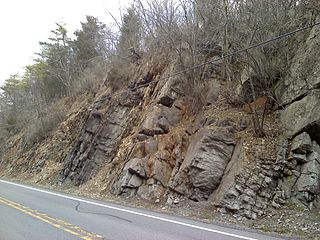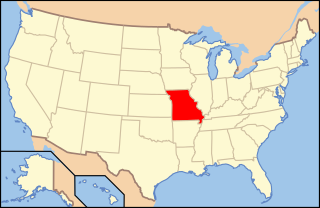Related Research Articles

Conodonts are an extinct group of agnathan (jawless) vertebrates resembling eels, classified in the class Conodonta. For many years, they were known only from their tooth-like oral elements, which are usually found in isolation and are now called conodont elements. Knowledge about soft tissues remains limited. They existed in the world's oceans for over 300 million years, from the Cambrian to the beginning of the Jurassic. Conodont elements are widely used as index fossils, fossils used to define and identify geological periods. The animals are also called Conodontophora to avoid ambiguity.
Paleontology or palaeontology is the study of prehistoric life forms on Earth through the examination of plant and animal fossils. This includes the study of body fossils, tracks (ichnites), burrows, cast-off parts, fossilised feces (coprolites), palynomorphs and chemical residues. Because humans have encountered fossils for millennia, paleontology has a long history both before and after becoming formalized as a science. This article records significant discoveries and events related to paleontology that occurred or were published in the year 1931.
Paleontology or palaeontology is the study of prehistoric life forms on Earth through the examination of plant and animal fossils. This includes the study of body fossils, tracks (ichnites), burrows, cast-off parts, fossilised feces (coprolites), palynomorphs and chemical residues. Because humans have encountered fossils for millennia, paleontology has a long history both before and after becoming formalized as a science. This article records significant discoveries and events related to paleontology that occurred or were published in the year 1941.
Paleontology or palaeontology is the study of prehistoric life forms on Earth through the examination of plant and animal fossils. This includes the study of body fossils, tracks (ichnites), burrows, cast-off parts, fossilised feces (coprolites), palynomorphs and chemical residues. Because humans have encountered fossils for millennia, paleontology has a long history both before and after becoming formalized as a science. This article records significant discoveries and events related to paleontology that occurred or were published in the year 1934.
Taphrognathus is an extinct genus of conodonts from the Dinantian.

Anaschisma is an extinct genus of large temnospondyl amphibians. These animals were part of the family called Metoposauridae, which filled the crocodile-like predatory niches in the late Triassic. It had large skull about 62 centimetres (24 in) long, and possibly reached 3 metres (9.8 ft) long. It was an ambush hunter, snapping up anything small enough to fit in its huge jaws. It was very common during the Late Triassic in what is now the American Southwest.

The Late Silurian to Early Devonian Keyser Formation is a mapped limestone bedrock unit in Pennsylvania, Maryland, Virginia, and West Virginia.

Paleontology in Wisconsin refers to paleontological research occurring within or conducted by people from the U.S. state of Wisconsin. The state has fossils from the Precambrian, much of the Paleozoic, and the later part of the Cenozoic. Most of the Paleozoic rocks are marine in origin. Because of the thick blanket of Pleistocene glacial sediment that covers the rock strata in most of the state, Wisconsin’s fossil record is relatively sparse. In spite of this, certain Wisconsin paleontological occurrences provide exceptional insights concerning the history and diversity of life on Earth.

Paleontology in Missouri refers to paleontological research occurring within or conducted by people from the U.S. state of Missouri. The geologic column of Missouri spans all of geologic history from the Precambrian to present with the exception of the Permian, Triassic, and Jurassic. Brachiopods are probably the most common fossils in Missouri.
The Richmond Group is a geologic group in Michigan. It preserves fossils dating back to the Ordovician period.
Bactrognathus is an extinct genus of conodonts in the family Bactrognathidae.
Maurice Goldsmith Mehl was an American paleontologist. A longtime professor in the Department of Geology at the University of Missouri, Mehl was a founding member and officer of the American Association of Petroleum Geologists. Mehl was a fellow of the Geological Society of America (1922), the Paleontological Society, and the American Association for the Advancement of Science (1915).
Ozarkodina is an extinct genus of conodonts in the family Spathognathodontidae.
George Jennings Hinde was a British geologist and paleontologist.
Ctenognathodus is an extinct conodont genus in the family Kockelellidae.
Spathognathodus is an extinct conodont genus in the family Spathognathodontidae. It is a non-Platform conodont, from the Pennsylvanian (Carboniferous).
Icriodus is an extinct conodont genus in the family Gnathodontidae.
Distomodus is an extinct genus of conodonts.
Rhipidognathidae is a family of multielement conodonts from the Ordovician.
Raymond (Ray) Lindsay Ethington is an American paleontologist. He works in the Geology department at the University of Missouri in Columbia, Missouri
References
- ↑ "Branson Field Laboratory – Teaching Field Geology Since 1911". University of Missouri College of Arts and Sciences: Geology Field Camp. March 16, 2021. Retrieved December 12, 2022.
- ↑ Pryor, Mick (July 15, 2022). "#Lookback: Missouri Geology Camp Branson Field Laboratory". County 10. Retrieved December 12, 2022.
- ↑ Origin of thick gypsum and salt deposits. E. B. Branson, GSA Bulletin, volume 26, no. 1, pagess 231-242, doi : 10.1130/GSAB-26-231
- ↑ Fishes of the Jefferson Formation of Utah. E. B. Branson and M. G. Mehl, The Journal of Geology, Vol. 39, No. 6 (Aug. - Sep., 1931), pages 509-531 (Stable URL, retrieved 29 April 2016)
- ↑ Conodonts from Glassy Creek Shale of Missouri. EB Branson and MG Mehl, Univ. Missouri Studies, 1934
- ↑ The Conodont Genus Icriodus and Its Stratigraphic Distribution. E. B. Branson and M. G. Mehl, Journal of Paleontology, Vol. 12, No. 2 (Mar., 1938), pages 156-166 (Stable URL retrieved 29 April 2016)
- ↑ New and Little Known Carboniferous Conodont Genera. E. B. Branson and M. G. Mehl, Journal of Paleontology, Vol. 15, No. 2 (Mar., 1941), pages 97-106 (Stable URL, retrieved 29 April 2015)
- ↑ Geology of Wind River Mountains, Wyoming. E. B. Branson and C. C. Branson, AAPG Bulletin, Volume: 25 (1941), Issue: 1. (January), pages 120-151 (abstract retrieved 29 April 2016)
- ↑ Conodonts. EB Branson and MG Mehl, in HW Shimer and RR Shrock, Index Fossils of North America. 1944
- ↑ Lower Silurian Conodonts from Kentucky. E. B. Branson and C. C. Branson, Journal of Paleontology, Vol. 21, No. 6 (Nov., 1947), pages 549-556 (Stable URL retrieved 29 April 2016)
- ↑ Richmond Conodonts of Kentucky and Indiana. E. B. Branson, M. G. Mehl and C. C. Branson, Journal of Paleontology, Vol. 25, No. 1 (Jan., 1951), pages 1-17 (Stable URL retrieved 29 April 2016)